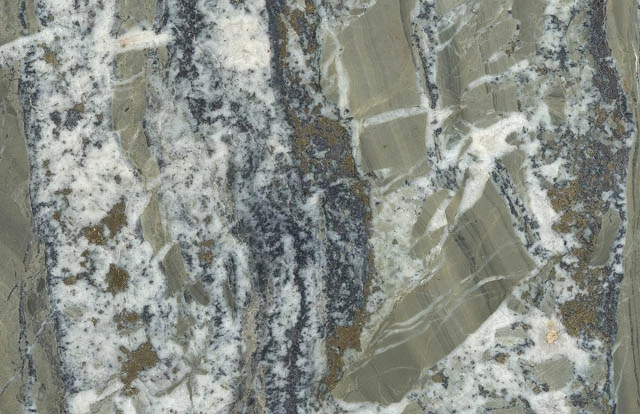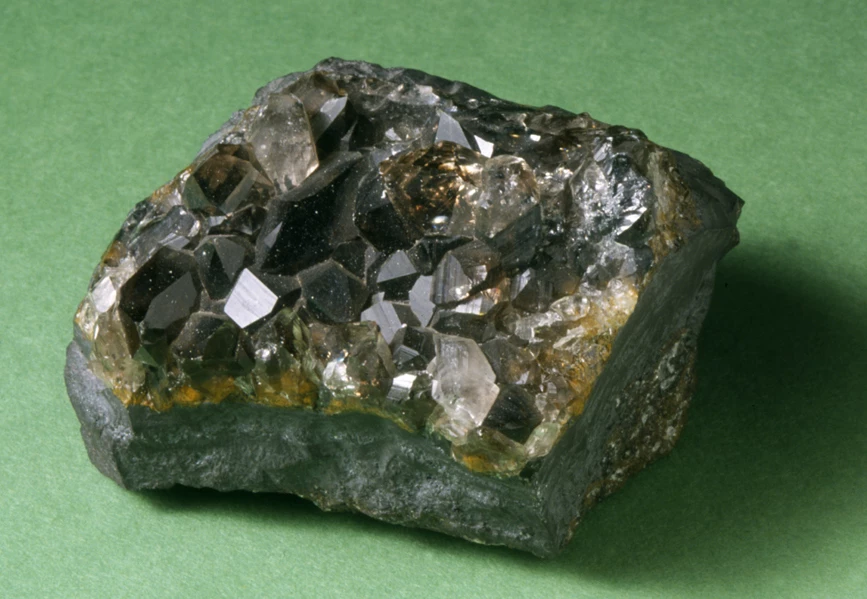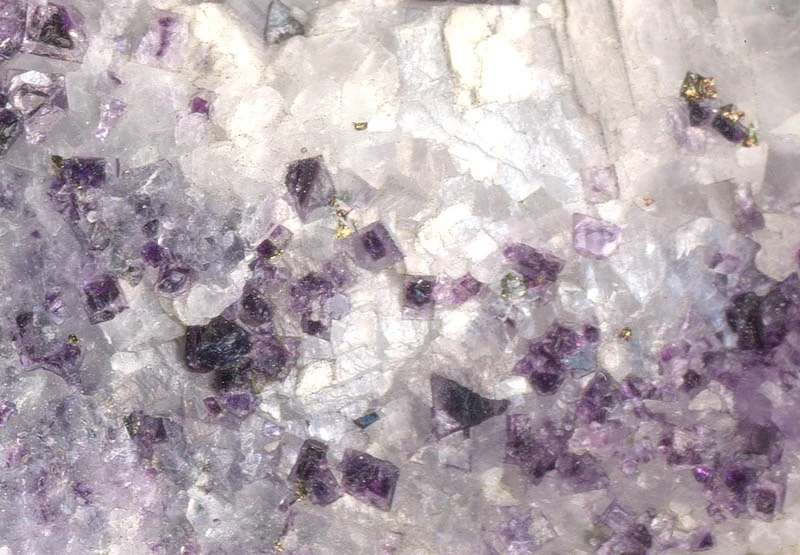Hydrothermal Minerals
Introduction
Wales has an abundance of hydrothermal (literally meaning ‘pertaining to hot water’) mineral deposits. Hydrothermal activity occurs at many levels in the Earth's crust, from deep-down (a kilometre or more) to the surface (fumarolic deposits around geysers) with hydrothermal fluids generated by igneous, metamorphic and sedimentary processes or a combination of these. All that is required is water and a heat-source which allow the fluids to perform one important task – to concentrate elements.
Hydrothermal mineral deposits may contain a vast range of different mineral's, including native elements, sulphides, oxides, halides, carbonates, sulphates, phosphates and silicates. The mineralogy of any one deposit reflects a variety of things, the two most important are:
- the chemistry of the fluid (which is controlled both by its source and the chemistry of the rocks through which it has passed).
- the physical conditions (temperature and pressure) at the time of mineralization.
Alpine Fissure-type veins
Alpine Fissure-type veins are localized mineral deposits hosted by competent (hard) lithologies, such as tuff or sandstone beds, igneous sills and dykes. They are particularly conspicuous where such rock units occur within deformed sequences of less competent (soft) rocks such as mudstones, and are formed as a consequence of the response of the competent rocks to the immense compressive forces that prevail during the deformation. During deformation, incompetent rocks are literally squashed, often into complex folds: however, a competent bed cannot accommodate the stress in this way and instead it fractures repeatedly due to its inherent brittleness. Alpine Fissure-type veins are the mineralized infillings of the fractures.
The very localized hydrothermal systems responsible for the deposition of the minerals in Alpine Fissure-type veins are capable of dissolving rock-forming minerals, including relatively immobile substances like titanium oxides. Compressive pressure-solution mechanisms are thought to be involved with the dissolution process. In this relatively high-pressure environment (due to the compressive forces that prevail during this type of deformation), the sudden creation of an open, brittle fracture forms a localized low-pressure zone (i.e. a space) into which any hydrothermal fluids in the immediate area will immediately migrate and precipitate minerals.
Alpine-Fissure-type veins are common in the deformed Lower Palaeozoic rocks of North Wales. Some very fine crystallized mineral specimens are known from these veins: apart from the dominant mineral, quartz, these include albite, clinozoisite, anatase, brookite, synchysite, monazite, xenotime, axinite and various sulphides. The brookite crystals formerly obtained from the now closed locality of Prenteg, near Tremadog in Snowdonia, are among the world’s finest examples of the mineral.
Amygdale infill and veins in volcanic rocks
Hot fluids, either resulting from volatiles in the magma, or from the heating and circulation of fluids in the rocks into which a magma intrudes, can dissolve chemical elements from both the lava and the country rock. As the circulating fluids cool they precipitate low-temperature mineral assemblages.
In other areas such low-temperature mineralization, deposited from hydrothermal systems associated with lavas and near-surface intrusions, are the source of finely-crystallized zeolite specimens. However in Wales this style of mineralization is poorly represented.
Eruptive volcanic rocks and shallow intrusions are common in the Lower Palaeozoic rocks of Wales, but the original amygdale-minerals have generally been altered by subsequent low-grade regional metamorphism. The only primary amygdale mineralization in Wales is restricted to a small number of dykes of Tertiary age which outcrop across parts of northern Gwynedd and Anglesey. Typical minerals include, analcime, calcite and prehnite.
Copper-dolomite association
The copper-dolomite association consists of saddle dolomite (with its noticeably curved crystals) in association with major chalcopyrite and minor pyrite, forming replacement deposits in carbonate rocks. It occupies faults, bedding planes, joints and vugs within extensively dedolomitized limestones.
This style of hydrothermal mineralization is thought to be derived from residual fluids formed during deposition of large sedimentary-exhalative Pb-Zn deposits, such as those of the Irish Midlands. Such fluids are magnesium-rich and sulphur-poor, and they readily precipitate saddle dolomite when they encounter carbonate rocks high in the Earth's crust. Copper is scavenged during the migration of the fluid from source rocks such as oxidized continental sandstones or volcanics.
The Great Orme copper deposits near Llandudno in North Wales are the best UK example of this class of mineral deposits. The mineralization, which in the upper parts of the mines has undergone heavy supergene alteration, consists of veins, bedding-plane ‘flats’ and irregular void infills in dedolomitized Carboniferous Limestone. Irregular, highly vuggy deposits are characteristic. The Great Orme ‘ore’ typically shows, when not oxidized, saddle-dolomite with its characteristic curved crystals forming crusts on limestone and studded with chalcopyrite crystals. Although calcite is common at Great Orme, it is entirely of supergene origin.
Epithermal polymetallic veins & pipes
Epithermal mineralization is emplaced at low-temperatures (50-200°C) in environments close to the surface at depths of less than 1 km. It often contains exotic elements such as mercury, antimony, silver and gold. Several sub-types are recognized globally, of which two are known from Wales, restricted to two areas: firstly in the upper part of the Coed-y-Brenin porphyry-copper system (Fe-Ag-Au) and secondly at Deganwy in North Wales (Sb-Pb).
At the shallow levels in the Earth's crust where epithermal deposits are formed, abrupt changes in physical and chemical conditions result in mineral precipitation and often intense hydrothermal alteration of the host-rocks. Factors that influence the conditions prevailing in this environment, and which therefore dictate the character of the mineralization, include the local geology (and hence permeability and reactivity of host rocks) and the pressure and temperature of the hydrothermal fluid (water at temperatures in excess of 100°C can remain liquid under high pressure but as it nears a low-pressure environment it boils suddenly and often explosively). The hydrothermal fluids may be of residual magmatic origin, but commonly they are generated when groundwaters are heated by a body of molten rock, such as a sub-volcanic magma-chamber.
Epithermal deposits occur commonly as pipe-like zones in which the rocks are brecciated and highly altered. Veins can also occur, especially along fault-zones: however such vein mineralization is typically discontinuous. Texturally, minerals often show banding and open-space growths into vugs.
In volcanic districts, epithermal systems are common and they frequently reach the surface, whence the boiling hydrothermal fluids erupt as geysers and fumaroles. Many old epithermal mineral deposits represent the fossilised ‘roots’ of ancient fumarolic systems. Because such things are near-surface features, erosion often removes them in due course, which is why old epithermal mineral deposits are relatively uncommon worldwide. Most of them are of Mesozoic age or younger.
Limestone hosted hematite deposits
This distinctive class of mineralization consists of low-temperature, iron oxide-dominated mineral assemblages occurring along faults, in karstic voids and as replacement bodies in Carboniferous Limestone. Occurrences are characterized by an often irregular geometry, with pipe or lens-like ore bodies a common development. They generally have a massive form, but with vuggy areas containing well-crystallized paragenetically late minerals. Hematite, goethite, quartz, calcite, dolomite and baryte are the commonest minerals present, while, characteristically, the wallrocks are extensively dolomitized.
Although there are similarities in the mode of formation to Mississippi Valley type deposits, the means by which the hydrothermal fluids were generated and also the fluid geochemistry differ strongly in this case. It is generally accepted that the fluids were formed from low-temperature neutral to alkaline brines derived from Triassic Sabhka (salt-flat) environments: the brines, rich in iron leached from Triassic red-beds, are thought to have interacted with warmer fluids originating from greater depths. This is an unusual type of mineral deposit with very few examples known outside of the UK. The most extensively developed UK example is the West Cumbria iron-mining district, but there are important examples in the Llantrisant-Taff's Well area of South Wales, including the iron-ores worked at Llanharry and Mwyndy mines.
Mesothermal polymetallic veins
Mesothermal literally means medium-temperature, and refers to hydrothermal mineral deposits formed at between 200-300°C. A number of mineralization types fall within this division but an important class, so far as Wales is concerned, is that of polymetallic veins.
Polymetallic veins are common in the Lower Palaeozoic rocks of Wales, with examples known from Pembrokeshire, throughout Central Wales into Snowdonia and on Anglesey.
Typically, they occupy faults, fissure-fractures and shear-zones. The mineralization may extend right along such structures, or may be developed intermittently along them. Repeated movements and pulses of mineralizing activity are typical. Dips may vary considerably and a common feature is steep dips in competent rocks (e.g. sandstones, dolerite sills) and less steep dips in incompetent rocks (e.g. shales, mudstones). Wallrocks are commonly altered, with a bleached appearance.
Polymetallic veins carry copper, lead, zinc, silver and gold (all of economic importance), arsenic, antimony, iron and a wide-ranging suite of accessory metals, often occurring as rare sulphides, arsenides or tellurides. They may form by a number of processes, of which two are important in Wales:
- Metamorphism: When thick sequences of sedimentary and volcanic rocks are buried to greater and greater depths they are subjected to increasing pressures and temperatures, resulting in low-grade metamorphism. This liberates significant amounts of water from hydrated minerals, such as clays, as they recrystallize. This water can then migrate as a hydrothermal fluid along suitable pathways through the rocks, such as faults and shear-zones, where minerals are deposited. Some of the best Welsh examples of such veins are those in the Dolgellau Gold-belt, hosted by Middle to Upper Cambrian sedimentary rocks and intrusions, and formed prior to the Caledonian deformation that uplifted the Welsh Basin in Devonian times. The veins occupy fault-fractures with strike lengths of several kilometres and typically reveal ribbonlike textures as in the example illustrated above. Metamorphic reactions causing widescale dewatering of deeply-buried rocks is believed to have been the mechanism which generated the hydrothermal fluids.
- Igneous activity: large-scale igneous centres, such as the caldera that dominated Snowdonia during Middle Ordovician times, are capable of generating hydrothermal fluids which form when groundwaters are heated at depth by a magma-chamber. The hot waters then rise up through the volcanic and surrounding sedimentary rocks in a process known as hydrothermal convection, again finding fracture-systems along which to migrate and precipitate minerals. The copper-rich veins of the Snowdon district were developed within a conjugate fracture-system related to the apical graben of the Snowdon Caldera, and are again pre-tectonic with respect to the end-Caledonian deformation.
Mississippi Valley Type (MVT) deposits
MVT deposits are formed from hydrothermal fluids that have migrated for considerable distances (sometimes >100 km) from their source. They consist of veins and replacement bodies which have been precipitated from low-temperature, highly saline metalliferous brines expelled from deep sedimentary basins. These are typically found within limestone-dominated districts: the Pennine orefields of the UK, developed within extensive outcrops of the Carboniferous Limestone, are classic examples
The classic formational model for MVT deposits involves the migration of the brines from the sedimentary basins into carbonate rocks typically associated with basement highs. The brines are generated by the same diagenetic processes that result in oil formation, and hydrocarbons often occur in MVT deposits. The fluids migrate via permeable strata and fracture-systems and the resultant mineralization consists of crustified veins, breccia cements, infills of karstic features and bedding-parallel replacement ‘flats’. The latter form when the brines react with limestone, dissolving it and replacing it typically with fluorite, baryte, calcite, sphalerite and galena. The mineralization is often coarsely crystalline with frequent crystal-lined cavities. Other, less common, minerals may also be present, especially if the brines have passed through igneous rocks and leached elements such as arsenic or copper from them.
The most extensive area of MVT mineralization in Wales is in the Halkyn-Minera district, where there are numerous old lead-mines. Good exposures of the veins are often present in the working limestone quarries of the area. Further examples occur in South Wales where exposures at Ogmore-on-Sea demonstrate the Mesozoic age of the mineralization.
Porphyry-type mineralization
Porphyry-type mineralization takes the form of disseminated ore minerals (chiefly of copper, molybdenum and gold) occurring within large bodies of intrusive acid to intermediate igneous rock. They are a particularly important source of copper in global terms: despite the typically low grades (sometimes less than 1% Cu), such orebodies can contain hundreds of millions of tonnes of reserves.
The host intrusions are typically emplaced at relatively shallow depths of 0.5-3 km and crystallize rapidly - leading to the porphyritic textures. The hydrothermal fluids separate out from the crystallizing magma and their high water and vapour pressures cause abundant shattering of both the intrusive and the country rocks around it; the fractures, often hairline cracks, are then mineralized in a well-zoned pattern. Alteration is also strongly zoned with a propylitic outer zone, in which the rocks are rich in chlorite with minor sericite, carbonate and epidote, and a phyllic inner zone, with abundant sericite, quartz and carbonates and minor chlorite. Sometimes, it is difficult to find evidence for magmatic fluids because meteoric (groundwater)-dominated hydrothermal convection can also occur, and this is able to overprint the original magmatic signature
There are a small number of deposits of this type in Wales, of which the finest is at Coed-y-Brenin in North Wales. Discovered as a result of an exploration programme in the late 1960s, it contains at least 200,000,000 tonnes of ‘ore’ grading at >0.3 Cu, the copper being present as chalcopyrite, bornite and tennantite.
Sedimentary exhalative deposits
Sedimentary-exhalative mineralization (often referred to as SedEx) involves the expulsion of hydrothermal fluids into sedimentary basins. Following contact with sea-water, minerals are precipitated from the fluids, and accumulate with the host sediments, often forming ores with a bedded appearance. SedEx deposits include base-metal, iron and manganese ores and are an important source of these commodities.
SedEx deposits characteristically develop within intracratonic or continental margin environments, in which they form on the floors of fault-controlled basins. Various models to account for hydrothermal fluid evolution have been proposed over the years, one being the convective circulation of seawater which upon heating is able to leach metals from the strata is passes through. The mineralizing brines then return to the seafloor along synsedimentary growth faults which act as exhalative centres. The brines may travel some distance from such centres but they will tend to accumulate in depressions on the seafloor where minerals are then precipitated and incorporated into the accumulating sedimentary rocks.
The manganese mines of the Harlech district all exploited a laterally persistant bed of manganese carbonates and silicates which has been interpreted as a distal sedimentary-exhalative deposit. In South Wales, important exposures at Ogmore-on-Sea reveal sedimentary-exhalative galena-baryte mineralization within the basal Lower Lias, which lies unconformably on Carboniferous Limestone carrying vein Pb-Ba mineralization of MVT type. The veins clearly represent feeders to the exhalative deposits. This exposure thus shows that the Liassic sediments have been mineralized, during their deposition, by the same hydrothermal fluids that emplaced the MVT vein mineralization: a Lower Jurassic age is therefore geologically demonstrated for the veins.
Serpentinization
Serpentinization is the process by which ultramafic mantle rocks, such as peridotite (composed of pyroxene and olivine) or dunite (composed dominantly of olivine) are altered under metamorphic conditions by the addition of water. This results in the replacement of the primary minerals by a suite of hydrous silicates such as the serpentine group of minerals (chrysotile, lizardite and antigorite), brucite, talc, and also magnetite and magnesium carbonate.
The main rock-forming minerals are chrysotile and antigorite. These are unable to accommodate iron, resulting from orthopyroxene and olivine breakdown into their structure. It is therefore common to find magnetite associated with chrysotile and it may constitute up to 5% of the rock. Excess magnesium may be incorporated into brucite or combine with other components in the rock to form secondary minerals such as dolomite, sepiolite or saponite.
Serpentinization occurs in three geological environments. In the mantle, in oceanic ophiolite complexes (where serpentinization may be linked to ocean floor metamorphism), and in collision belts. The most extensively developed serpentinite in Wales, is found on Holy Island, Anglesey, and was exploited during the eighteenth century as an ornamental stone.
Volcanogenic massive sulphide
Volcanogenic Massive Sulphide (VMS) deposits consist of massive to disseminated sulphide mineralization which was precipitated at or near to the discharge vents (‘black-smokers’) of hydrothermal systems on the sea floor.
This type of mineralization involves a convective hydrothermal cell driven by the heat of a sub-volcanic magma chamber, with metals being leached from the surrounding rocks through which the fluids (originally seawater) circulate. The fluid pathways to their discharge points on the seabed are controlled by the distribution of fracture-systems. Veins and stockworks consisting of numerous mineralized stringers commonly occur within the underlying rocks, marking such pathways. Upon exiting into the sea, precipitation of fine sulphide particles (the ‘black smoke’) occurs rapidly and mounds of sulphidic sediment build up around the fluid vents. These may accumulate to form lens-shaped sulphide bodies, sometimes hundreds of metres in length and tens of metres in thickness, or they may become entrained in submarine debris flows and incorporated into the resultant sedimentary rocks. Excessive dilution with sediment in this manner can have adverse implications for the development of ore-grade mineralization.
The best example of this type of deposit in Wales is at Parys Mountain on Anglesey, where a complex and highly altered rhyolite-chert-mudstone sequence of Middle Ordovician to Lower Silurian age hosts Cu-Zn-Pb-Ag-Au mineralization. The sulphides occur in complex, fine-grained intergrowths requiring ore petrology for their interpretation and the alteration is so intense that the geological structure and stratigraphy of the host rocks has proved extremely difficult to unravel.







